On June 4, 2014, Governor McCrory signed the Energy Modernization Act, which legalizes oil and gas exploration and development in the state of North Carolina.
 Dr. Sarah Carmichael studies the origins of shale gas and fluid-rock reactions, and answers some frequently asked questions about hydraulic fracturing, shale gas deposits, and the potential for energy resource development in North Carolina.
Dr. Sarah Carmichael studies the origins of shale gas and fluid-rock reactions, and answers some frequently asked questions about hydraulic fracturing, shale gas deposits, and the potential for energy resource development in North Carolina.
There has been a lot in the news lately about shale gas and fracking. What is shale gas? How is it different than other types of gas or oil?
As a geologist, I've seen a lot of confusion in the general public about where it's possible to find shale gas. Shale gas contains a variety of hydrocarbons that are trapped in the tiny pore spaces of shale rock (a very fine-grained sedimentary rock). It's different than traditional oil or gas deposits because unlike other source rocks, the hydrocarbons have not migrated into a reservoir rock (a rock with lots of holes in it, which is easy to extract oil/gas from). Since they're still trapped in the shale, the extraction techniques for traditional gas/oil wells don't work. Hydraulic fracturing a.k.a. "fracking" was developed to bust apart the tiny little pores in the shale and extract the trapped gas.
There's a lot of controversy and misinformation about the safety of fracking in the media now (from both the pro-fracking and anti-fracking movements), but I think the best resource to explain how fracking works and the potential groundwater and seismicity issues is the Geological Society of America's Critical Issue document on hydraulic fracturing. It is a non-partisan document written and illustrated for a lay reader, and is fully referenced to the scientific literature for those who are interested in getting more technical information. The Geological Society of America is a professional geoscience organization whose members represent geoscientists from a variety of disciplines.
Where do you find shale gas?
Shale gas doesn't just happen in random locations - the paleoenvironment has to be just right. You need to have a source of organic carbon (often this is terrestrial material washing into restricted marine basins or lakes, but sometimes it's based on major mass extinction events where lots of marine life dies and leaves a lot of organic carbon behind all at once). You need to have a geologic environment that's capable of preserving organic carbon for millions of years and not cooking it all away through metamorphism (heating and squishing that happens during mountain building events). The map below (from the Energy Information Administration, a federal agency) shows all the locations of currently or potentially economically viable shale gas deposits in the continental US.
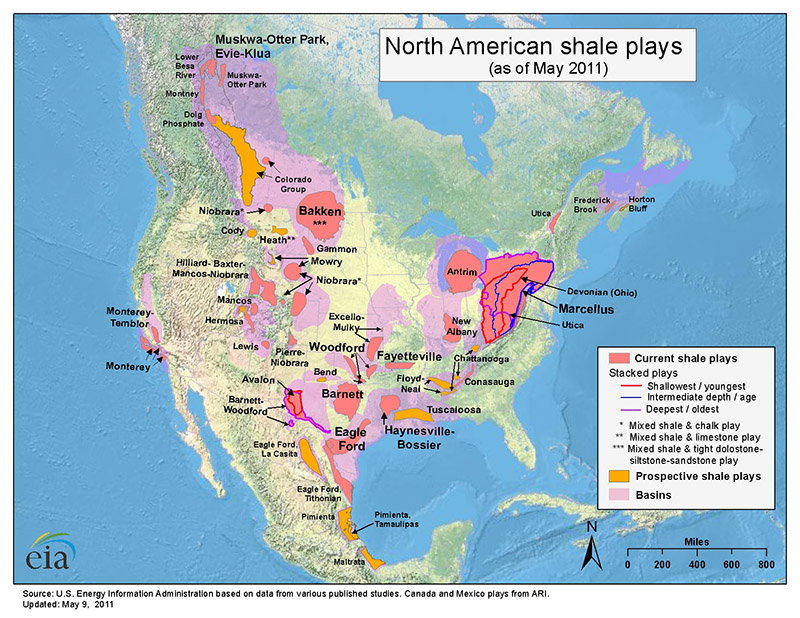
Much of the shale gas you see in the map above is middle to late Devonian in age (approximately 350-400 million years old). Major mass extinctions punctuated the middle and late Devonian, causing organic carbon (preserved now as natural gas) to be trapped in basins on the North American continent. Scientists like myself are still hashing out what exactly caused these mass extinctions. Regardless of the exact cause (or combination of causes), most of the major shale gas deposits in the US are associated with these ocean anoxia events during the middle and late Devonian (the header image at the top of this page illustrates one of my hypotheses about how this process works). This is what North America looked like in the Late Devonian (modified from http://cpgeosystems.com), where you can see the basins that trapped all the organic material that is now the natural gas that we're extracting via hydraulic fracturing:
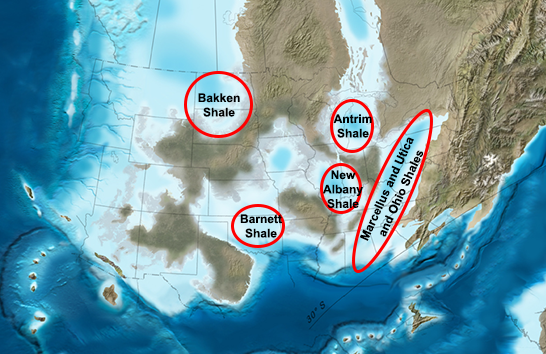
None of the maps above show any shale gas development in North Carolina. But we've been hearing a lot about the potential for shale gas development here. What areas of the state would be affected by this?
Most of the interest that the NC legislature has in potential energy development in NC is in shale gas is in the Triassic basins in the Piedmont. These are not the large shale gas deposits that formed in the Devonian shown in the pictures above; these are very narrow basins that were formed as the Atlantic Ocean was opening up in the Mid-Late Triassic (about 230-210 million years ago).
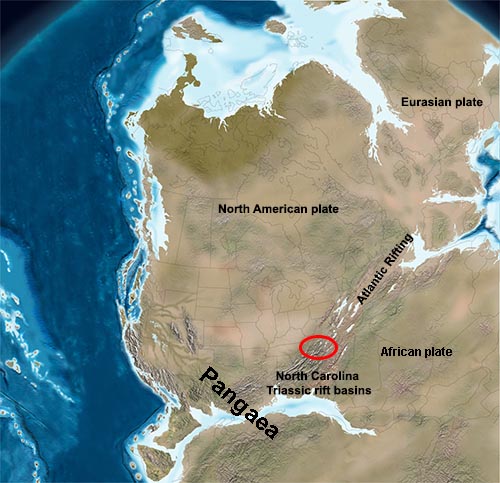
The image above (modified from http://cpgeosystems.com) shows what the landscape would have looked like in NC around the time the rift basins were forming. As Pangaea broke apart to form the Atlantic, there were lots of basins that developed along the east coast of the US. These basins are called "failed rifts" because they did not break apart enough to turn into ocean floor, but instead filled with sediment and stabilized. Those sediments were deposited in restricted lakes and tend to preserve organic carbon. Due to their tectonic environment, though, they also tend to be riddled with faults and often contain sheets of magma (called basalt dikes).
The map of NC (below) shows the location of Triassic basins in North Carolina. It's from the United States Geological Survey (USGS) publication Hydrocarbon Source Rocks in the Deep River and Dan River Triassic Basins, North Carolina (PDF) (where you can find more detailed information about these basins). Part of the job of the USGS is to assess energy and mineral resource potential around the country.
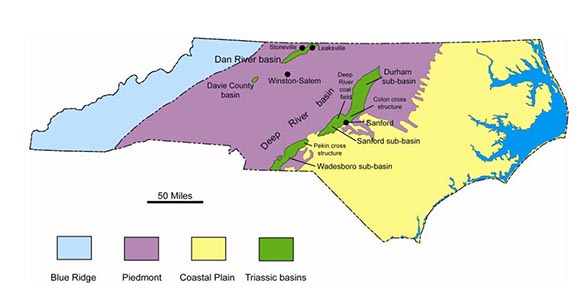
To put this in context, this is how a Triassic basin looks in cross section (image below from http://www.learnnc.org from the UNC School of Education). The Triassic basins (shown in red) are really pretty narrow and deep in comparison to the established gas fields (such as the Marcellus, Bakken, and Utica shales that span multiple states). Compared to these gas fields in Devonian basins, rift basins represent really, really tiny gas deposits.
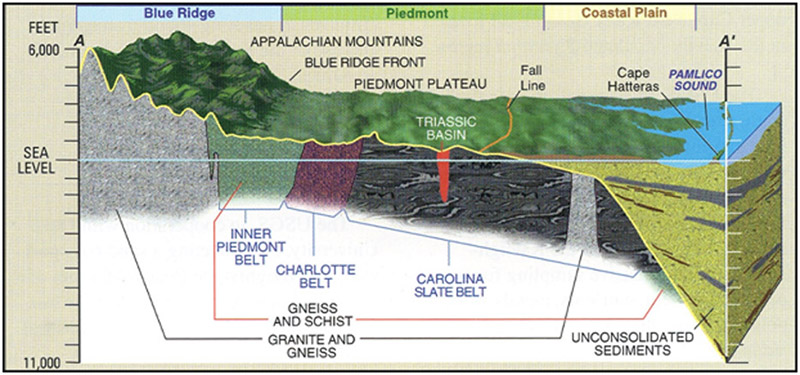
There has been talk about natural gas development in western NC. What's going on there? There are no Triassic rift basins on the map in those counties (Cherokee, Clay, Graham, Haywood, Jackson, Macon and Swain).
There are no Triassic basins in those counties, that's true. However, there are Precambrian rift basins which are hundreds of millions of years older (they were deposited over 640 million years ago!). These Precambrian rift basin sediments are part of the Ocoee Supergroup rocks, which you see in the Great Smoky Mountains and the counties in western NC. The Ocoee Supergroup sediments represent sediments deposited in a rift environment from when the supercontinent Laurentia (which we were once a part of) rifted apart to form the Iapetus Ocean (which is no longer an ocean, it's since been subducted back into the mantle through plate tectonics). This happened before there were plants on land or any marine life besides single-celled organisms. This is what the world looked like in the Precambrian (again, from http://cpgeosystems.com):

The potential for natural gas deposits in Precambrian rifts is still unknown. However, the Ocoee Supergroup sediments were metamorphosed to graphite schists and other metamorphic rocks when the Appalachians formed. Metamorphism causes the breakdown of the original minerals and the formation of new minerals under high pressures and temperatures. You can get more information about the types of rocks in this region by going to the USGS map for NC - click anywhere on the map and a window will open telling you what rocks are present. You can see that the Ocoee Supergroup rocks are all classified as metasedimentary rocks (metamorphosed sediments).
Graphite (the mineral that makes pencil lead) forms in sediments through the breakdown of hydrocarbons and carbonate minerals during metamorphism. If you have graphite in a metamorphic rock, it means that the available carbon in the rock has reacted with other minerals and fluids (such as iron carbonates, CO2, O2, and sulfide minerals), although the chemical reactions that guide this process are still not well understood since there are so many variabilities in natural systems 1-3. Although hydrocarbons can exist in low-grade metamorphic systems, the fluids often migrate as part of this process4. While it remains unlikely that there are any recoverable hydrocarbons left in most of the rocks that have been metamorphosed under the conditions that the Ocoee Supergroup sediments were subjected to during mountain building, more research on metamorphic hydrocarbon mobility certainly needs to be done.
But aren't there test wells being drilled in western NC?
The Asheville Citizen-Times reported in June 2014 that DENR (the NC Department of Energy and Natural Resources) would begin drilling test wells in western NC to check for the presence of natural gas deposits. According to Dr. Kenneth Taylor (State Geologist of North Carolina, DENR), this plan has changed since the legislature revised the available exploration budget and test wells in western NC are no longer planned by DENR at the time of this writing (October 2014). Originally, DENR was tasked with testing the rocks in parts of western NC for the available organic carbon content, since the presence of certain metamorphic minerals indicates that the rocks may or may not have reached the thermal conditions that are best for hydrocarbon development and storage. It is important to note that this exploration and testing was requested by the NC legislature (prior to the budget revisions). To my knowledge there have been no oil or gas companies who have been interested in developing the Precambrian rift sediments in western NC.
What about Ashe County? I've heard there's going to be gas exploration and development in the northwestern part of the county.
The rocks in Ashe and Watauga counties are completely unfit for gas development. They are a mix of very old, high grade metamorphic rocks (like the Cranberry Gneiss, Blowing Rock Gneiss, and Ashe Metamorphic Suite, among others) and lower grade volcanic rocks (the Mt. Rogers Formation). Hydrocarbons cannot be found in any of these types of rocks, as they either have been cooked away hundreds of millions of years ago and/or there was never organic carbon there to begin with. Any fears about fracking in the High Country are totally unfounded. More information specific to the fracking rumors in Ashe County can be found in the Jefferson Post.
I've heard that fracking causes earthquakes. Is this true?
Fracking in itself causes very minor seismicity. However, injection of fracking fluid byproducts back into the ground has been known to be a seismic hazard since the late 1960s. To avoid surface groundwater contamination one of the disposal methods of this fluid is to inject it back deep underground where it came from. However, care must be taken that injection wells are located in regions that do not contain old faults that can be reactivated as part of the process. The injection-associated earthquakes are not very strong (certainly not as strong as earthquakes seen around plate boundaries, like in California or Japan or Chile), but in areas that are not usually seismically active they do pose a danger, as microfaults or old faults that are normally locked up become "slippery" with injection fluids. The extent of injection well induced seismicity can be a serious hazard, as seen in the earthquake swarms in Oklahoma.5
What do you think about fracking, personally?
As long as there are proper regulations in place, and these regulations are actually enforced, I think it can be done safely. Natural gas is less polluting than coal for electricity, and far more efficient. But like any extractive industry, there is always going to be some environmental impact. I think it's important to have a national energy policy that balances local environmental impact with the economic needs of a region, and that communities who are going to bear the brunt of the environmental impact are compensated adequately. Unfortunately, this balance doesn't always happen, and existing regulations are not always enforced, resulting in a lot of tension between local communities and industry.
Any take-home messages you want to give?
Yes! It's important to remember that even if you live on or near a gas deposit, it's not always economical to develop it - this could be due to state or federal environmental regulations, technical limitations of how to access the gas, or simply that the potential volume of extractable gas preserved is not worth the start-up and infrastructure costs associated with well development. Well development is very expensive - companies will only invest in a gas well operation if the potential for profit is high. If you are concerned about resource development in your region, remember to step back and ask "what kind of rock do I live on?" - if you're in North Carolina, chances are the rocks you live on are not optimal for hydrocarbon extraction.
References
- Hall, D. L., Bodnar, R. J., & Craig, J. R. (1991). Evidence for postentrapment diffusion of hydrogen into peak metamorphic fluid inclusions from the massive sulfide deposits at Ducktown, Tennessee. Am. Mineral, 76, 1344-1355.
- Helgeson, H. C. (1991). Organic/inorganic reactions in metamorphic processes.The Canadian Mineralogist, 29(4), 707-739.
- Holloway, J. R. (1984). Graphite-CH4-H2O-CO2 equilibria at low-grade metamorphic conditions. Geology, 12(8), 455-458.
- Evans, K. (2011). Metamorphic carbon fluxes: how much and how fast?.Geology, 39(1), 95-96.
- Hand, E. (2014). Injection wells blamed in Oklahoma earthquakes. Science, 345(6192), 13-14.
